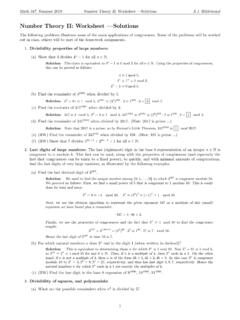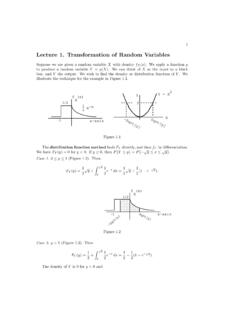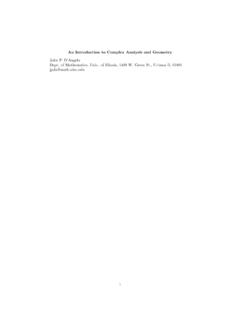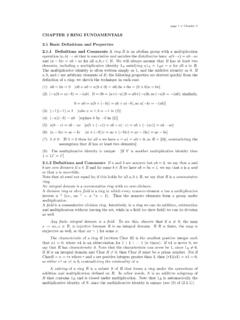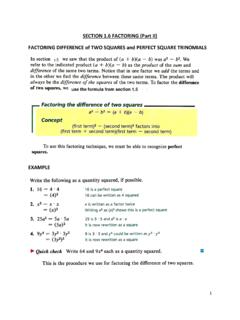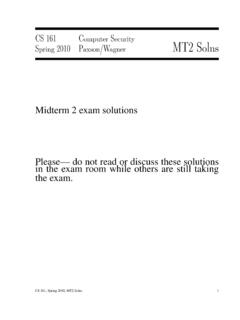Transcription of Math 408, Spring 2008 Midterm Exam 2 Solutions
1 math 408, Spring 2008 Midterm Exam 2 Solutions1. (NO CALCULATORS FOR THIS PROBLEM)(a) Consider the following statements:(1) If Cov(X,Y) = 0, thenXandYare independent.(2) IfXandYare independent, then Cov(X,Y) = one of the following:(i) Only (1) is correct.(ii) Only (2) is correct.(iii) (1) and (2) are both correct.(iv) Neither (1) nor (2) are (ii), , (2) is correct, but not (1). (Note that, while independence implies thatthe covariance is zero, the converse is not true. In fact, a homework problem ( ) gave anexample of two random variables that had 0 covariance, but were not independent.(b) Suppose thatXandYare independent random variables with Var(X) = 1, Var(Y) = Var(1 2X+ 3Y).)
2 Solution.(Except for a minor numerical change, this was a quiz problem.)Var(1 2X+ 3Y) = 0 + ( 2)2 Var(X) + 32 Var(Y) = 4 19 2 =22.(c) SupposeXandYare random variables such that Var(X+Y) = 9 and Var(X Y) = Cov(X,Y). haveVar(X+Y) = Var(X) + Var(Y) + 2 Cov(X,Y),Var(X Y) = Var(X) + Var( Y) + 2 Cov(X, Y)= Var(X) + Var(Y) 2 Cov(X,Y),(since Var( Y) = Var(Y) and Cov(X, Y) = Cov(X,Y)). Subtracting these two equa-tions and substituting the given values for Var(X+Y) and Var(X Y), we get 9 1 =4 Cov(X,Y), so Cov(X,Y) = (NO CALCULATORS FOR THIS PROBLEM) LetXbe a random variable with normal distri-butionN(10,4), and letY= 408 Midterm Exam 2 Spring 2008 (a) Find the ofX.
3 (The answer should be an explicit elementary function ofx, not anexpression involving .) density of a general normal distribution with parameters and isf(x) = (1/ 2 )e (x )2/(2 2). Here = 10, = 2, sof(x) =12 2 e 18(x 10)2, <x< .(b) Find the ofY. (Again, the answer should be an explicit elementary function ofy.) use the distribution function technique to compute first the (y) andthen the (y) ofY. SinceY=eXandXranges over the entire real axis, the possiblevalues forYare 0<y< . For suchywe haveG(y) =P(Y y) =P(eX y) =P(X lny) =F(lny).Differentiating and using the formula forf(x) from part (a), we getg(y) =G (y) =F (lny)1y=f(lny)y=12y 2 e 18(lny 10)2,0<y<.
4 3. (NO CALCULATORS FOR THIS PROBLEM) Claim amounts on a home insurance policy havedensity functionf(x) ={3x 4forx>1, two such claims are made, and assume the claim amounts are independent.(a) Find the (density) of thelargerof the two the two claims, and letX = max(X1,X2) be thelarger (maximum) of these claims. To find the (x) ofX , we first compute the (x) =P(X x), using the maximum trick : Forx 1,G(x) =P(X x) =P(max(X1,X2) x)=P(X1 x,X2 x) =P(X1 x)P(X2 x) =F(x) ,f(x) = 3x 4forx 1, soF(x) = x13t 4dt= 1 x 3, and thereforeG(x) = (1 x 3)2,g(x) =G (x) = 2(1 x 3)( ( 3)x 4)=6x 4 6x 7(x 1). math 408 Midterm Exam 2 Spring 2008 (b) Find the probability that the amount of thesecondclaim is at least twice that of , respectively, the first and second claims.}
5 Then we needto computeP(X2 2X1). By the independence ofX1andX2and the given density for anindividual claim, the joint density isf(x1,x2) = (3x 41)(3x 42) = 9x 41x 42,1<x1,x2< .HenceP(X2>2X1) = x1=1 x2=2x19x 41x 42dx2dx1= x1=19x 41[x 32 3] x2=2x1dx1= x1=13x 41(2x1) 3dx=38 x1=1x 71dx= (NO CALCULATORS FOR THIS PROBLEM) LetXandYbe random variables with jointdensityf(x,y) =32,0 x 1,x2 y 1.(a) Find the marginal densityfY(y) ofY. Be sure to specify the general formula isfY(y) = f(x,y)dxwith appropriate integration sketch of the region shows that the correct limits are fromx= 0 tox= y. Thus,fY(y) = yx=032dx=32y1/2,0 y 1.
6 (b) FindE(X|1/2), the conditional expectation ofXgiven thatY= 1 conditional density ofXgivenY= 1/2 ish(x|1/2) =f(x,1/2)fY(1/2)=3/2(3/2) 1/2= 2,0<x< 1 (X|1/2) = xh(x|1/2)dx= 1/20x 2dx= 2(1/ 2)22=12 (NO CALCULATORS FOR THIS PROBLEM) Suppose thatYis uniformly distributed on theinterval [0,4] and that, givenY=y,Xis uniformly distributed on the interval [y,y+ 2]. math 408 Midterm Exam 2 Spring 2008 (a) Determine the joint densityf(x,y). Be sure to specify the uniformly distributed on [0,4], we havefY(y) = 1/4,0 y , since, givenY=y,Xis uniformly distributed on [y,y+2], the conditional densityofXgivenY=yis 1/2 on the interval [y,y+ 2]; ,g(x|y) = 1/2,y x y+ 2 for0 y 4.
7 Thusf(x,y) =fY(y)g(x|y) =14 12=18,0<y<4,y<x<y+ 2(b) Find the marginal densityfX(x) ofX. Be sure to specify the [This is Problem in Hogg/Tanis, from HW Assignment 10. The key is tosplit up thex-range into three parts, and to calculatefX(x) separately for each of the threeparts.] The general formula isfX(x) = f(x,y)dy, with appropriate integration part (a) we havef(x,y) = 1/8, and from a sketch we see that the correct integrationlimits are 0 y xfor 0 x 2,x 2 y xfor 2 x 4,x 2 y 4 for 4 x ,fX(x) = x018dy=x8if 0 x 2, xx 218dy=14if 2 x 4, 4x 218dy=6 x8if 4 x Assume that the amount of fluid content contained in a can of soda has normal distribution withmean ounces and standard deviation ounces.
8 (a) Find the probability that a single can of soda contains less than 12 need to computeP(X<12) whereXis normalN( , ). Standardizing,we getP(X<12) =P(X <12 )=P(Z< 2) = 1 (2) = (b) Suppose that 50 cans are measured, and that the 50 measurements are averaged. Assumingindependence, determine a valuecsuch that, with probability , theaverageof these50 measurements is less need to determinecsuch thatP(X<c) = , whereXis the samplemean of the 50 sX1,..,X50. By the CLT,Xis approximately normal with mean = and standard deviation 50 = Standardizing, we haveP(X<c) =P(X <c )=P(Z<c )= (c )Setting this equal to , we find that (c ) = 2, soc= =



